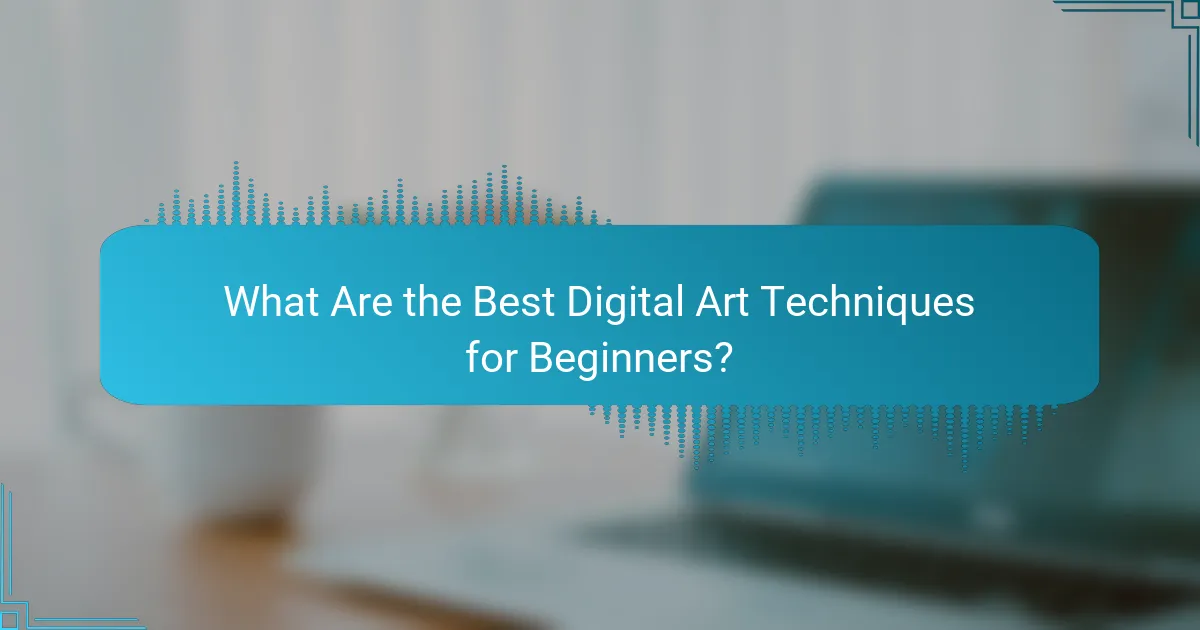Digital art offers a vast landscape for creativity, with techniques ranging from beginner methods to advanced skills. Starting with foundational skills like basic drawing, color theory, and layer management sets the stage for more complex concepts such as perspective and texturing. Additionally, effective character design combines anatomical accuracy and expressive features to create memorable characters that engage audiences and enhance storytelling.

What Are the Best Digital Art Techniques for Beginners?
The best digital art techniques for beginners include mastering basic drawing skills, understanding color theory, and learning how to use layers effectively. These foundational methods will help you create more polished and professional-looking artwork as you progress.
Basic Drawing Techniques
Basic drawing techniques involve understanding shapes, lines, and proportions. Start by practicing simple shapes like circles and squares, then gradually move to more complex forms. Regular sketching can improve your hand-eye coordination and help you develop a unique style.
Using a tablet or stylus can enhance your drawing experience, allowing for more precision and control. Experiment with different pressures to create varied line thicknesses, which adds depth to your work.
Color Theory Fundamentals
Color theory fundamentals cover the color wheel, color harmony, and the psychological effects of colors. Familiarize yourself with primary, secondary, and tertiary colors to understand how they interact. This knowledge will help you create visually appealing compositions.
Consider using complementary colors to create contrast or analogous colors for a more harmonious look. A simple rule is to limit your palette to a few colors to avoid overwhelming your artwork.
Layering and Blending
Layering and blending are essential techniques in digital art that allow you to separate elements of your artwork. Use layers to keep different components distinct, making it easier to edit without affecting the entire piece.
Blending techniques, such as using soft brushes or opacity adjustments, can create smooth transitions between colors. Practice blending to achieve realistic textures and depth in your art.
Using Digital Brushes
Using digital brushes effectively can significantly enhance your artwork. Explore various brush types, such as hard, soft, and textured brushes, to find what works best for your style. Most digital art software offers customizable brushes, allowing you to adjust size, shape, and opacity.
Experiment with different brushes for different effects; for instance, use a textured brush for backgrounds and a fine brush for details. Keep a few favorite brushes handy for consistency in your work.
Creating Simple Character Designs
Creating simple character designs starts with basic shapes and silhouettes. Focus on defining the character’s personality through posture and facial expressions. Sketch multiple iterations to explore different looks before finalizing your design.
Consider color choices and clothing that reflect the character’s traits. Using a limited color palette can help maintain cohesion in your design. Don’t hesitate to reference existing characters for inspiration while developing your unique style.

How to Develop Advanced Digital Art Skills?
To develop advanced digital art skills, focus on mastering techniques that enhance your creativity and efficiency. This includes understanding complex concepts like perspective, texturing, lighting, and character design, which can elevate your artwork significantly.
Mastering Perspective
Mastering perspective is crucial for creating depth and realism in digital art. Start by practicing one-point, two-point, and three-point perspectives, which help in accurately depicting objects in space. Use grid overlays in your software to guide your lines and maintain consistency.
Consider using reference images to study how perspective affects various scenes. For example, urban landscapes often require a two-point perspective, while interiors may benefit from a one-point approach. Regularly sketching from life can also enhance your understanding of spatial relationships.
Advanced Texturing Techniques
Advanced texturing techniques can add richness and detail to your digital artwork. Explore methods like photo-bashing, where you combine photographic elements with your illustrations, and hand-painted textures for a more organic feel. Layering textures can create depth and interest.
Utilize software features such as texture brushes and custom patterns to enhance your work. Keep in mind that subtlety is key; overly complex textures can distract from the main subject. Aim for a balance that complements your overall composition.
Dynamic Lighting and Shadows
Dynamic lighting and shadows are essential for creating mood and dimension in your art. Understand the light source’s position and intensity to accurately depict how it interacts with objects. Experiment with different lighting scenarios to see how they affect your artwork’s atmosphere.
Use layers to separate light and shadow elements, allowing for easier adjustments. Consider studying real-world lighting conditions, such as golden hour or harsh midday sun, to grasp how colors and shadows change. This practice will improve your ability to create compelling visual narratives.
Complex Character Design
Complex character design involves creating unique and believable characters with distinct personalities. Start by developing character backstories, which can inform their visual traits and expressions. Sketch multiple iterations to explore different styles and features.
Pay attention to proportions and anatomy, as these elements are vital for realism. Use references from various sources, including anatomy books and character design tutorials, to enhance your understanding. Remember to incorporate diverse cultural influences to enrich your character designs.

What Are Effective Character Design Approaches?
Effective character design approaches focus on creating memorable and relatable characters through a combination of concept development, anatomical accuracy, expressive features, and thoughtful color schemes. These elements work together to ensure that characters resonate with audiences and serve their intended purpose in storytelling.
Character Concept Development
Character concept development involves brainstorming and refining ideas that capture the essence of the character. Start by defining the character’s role, personality traits, and backstory, as these factors will influence their visual design. Sketch multiple iterations to explore different styles and features before settling on a final concept.
Consider using mood boards to gather inspiration from various sources, such as art, literature, and culture. This can help in visualizing the character’s environment and emotional tone, ultimately guiding the design process.
Proportions and Anatomy
Understanding proportions and anatomy is crucial for creating believable characters. Start with basic shapes to establish the overall silhouette and then refine the details based on the character’s age, species, and style. For example, exaggerated proportions can convey a cartoonish feel, while realistic anatomy is essential for more serious designs.
Utilize reference images to study human and animal anatomy, focusing on key areas such as limbs, torso, and head. This practice will enhance your ability to depict movement and posture accurately, making your characters more dynamic and engaging.
Expressive Facial Features
Facial features play a significant role in conveying emotion and personality. Focus on the eyes, mouth, and eyebrows, as these areas are key to expressing a range of feelings. Experiment with different shapes and placements to find what best represents your character’s emotions.
Practice drawing various expressions to understand how subtle changes can impact the character’s overall demeanor. Remember that consistency in facial features is important for maintaining character recognition across different poses and scenes.
Color Schemes for Characters
Choosing the right color scheme is vital for character design, as colors evoke emotions and set the tone. Start by selecting a primary color that reflects the character’s personality, then build a palette with complementary and contrasting colors to add depth and interest.
Consider cultural associations with colors, as they can influence how characters are perceived. For example, red may symbolize passion or danger, while blue can evoke calmness or sadness. Test your color choices in different lighting conditions to ensure they work well in various contexts.

What Tools Are Essential for Digital Art?
Essential tools for digital art include software applications, hardware devices, and online resources that facilitate the creation and enhancement of digital artwork. Selecting the right combination can significantly impact your workflow and artistic output.
Popular Software Options
Popular software for digital art includes Adobe Photoshop, Corel Painter, and Procreate. Each program offers unique features tailored to different styles and techniques, such as raster graphics or vector art.
For beginners, free options like Krita and GIMP provide robust tools without the financial commitment. As you advance, consider investing in subscription-based software for more sophisticated capabilities and regular updates.
Recommended Hardware
Key hardware for digital artists includes a reliable computer or tablet and a graphics tablet for precision. A mid-range laptop or desktop with a good graphics card will typically suffice for most digital art tasks.
For tablets, options like the Wacom Intuos or iPad Pro are popular due to their responsiveness and pressure sensitivity. Ensure your device has a screen size that suits your working style, typically between 12 to 16 inches for portability without sacrificing usability.
Useful Online Resources
Online resources such as YouTube tutorials, digital art forums, and platforms like Skillshare offer valuable learning opportunities. Websites like DeviantArt and ArtStation can also provide inspiration and community feedback.
Consider joining online courses or workshops to deepen your skills and connect with other artists. Many resources are available for free or at a low cost, making them accessible for beginners and seasoned artists alike.

How to Choose the Right Digital Art Style?
Choosing the right digital art style involves understanding your artistic goals and the message you want to convey. Consider your audience and the medium in which your art will be displayed, as these factors can significantly influence your style selection.
Beginner Methods
For beginners, exploring various digital art styles can help identify what resonates most. Start with popular styles like cartoon, realism, or abstract, and experiment with each to see which aligns with your interests. Utilize free resources and tutorials available online to practice these styles.
As you experiment, focus on mastering basic techniques such as line work, color theory, and shading. These foundational skills will enhance your ability to adapt and refine your chosen style over time.
Advanced Skills
Advanced digital artists often develop a unique style that reflects their personal experiences and influences. This can involve combining elements from different styles or creating entirely new techniques. Study the work of established artists to gain inspiration and insight into advanced methods.
Consider investing in professional software and tools that allow for greater flexibility and precision in your work. Techniques such as layering, blending modes, and custom brushes can elevate your art and help you achieve a polished look.
Character Design Approaches
When designing characters, it’s crucial to establish a clear concept that conveys personality and emotion. Start with sketches that explore different poses and expressions, focusing on how these elements reflect your character’s traits.
Utilize color palettes that enhance the character’s mood and story. For instance, warm colors may evoke excitement, while cool colors can suggest calmness. Pay attention to proportions and anatomy, as these aspects can significantly impact the character’s believability.
Finally, gather feedback from peers or online communities to refine your character designs. Constructive criticism can provide valuable insights and help you improve your skills and style.


